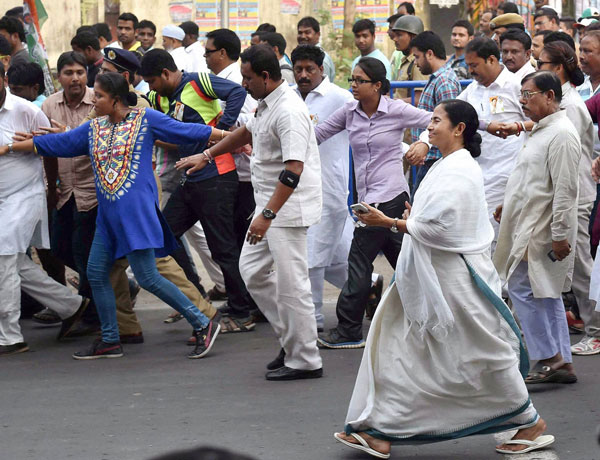West Bengal Polls, A Curtain Raiser

KOLKATA: Electoral stakeholders in West Bengal have now finally geared up for the sixteenth Assembly election. More than 65 million electors will go on poll scheduled between April 4-May 5, 2016 to elect 294 delegates to represent more than 90 million state populations.
In the last three months, the state has witnessed elaborate road- shows, bike rallies, and intense door-to-door campaigns with a mix of local and national political issues that have put the political character of West Bengal on full display. Multi-lingual manifestos, party anthems, jingles, the audio-video campaign songs, large hoardings and posters add further colour to the election campaign of West Bengal.
The most interesting part of this 2016 election is the link between voters, candidates and parties and the in?uence of the campaign context on these relationships. Keeping in view local popularity, political parties have nominated candidates from across the professional spectrum including actors, sports persons, corporate sectors, media persons, lawyers, doctors and so on. Congress-Left-BJP have introduced new and young faces while the ruling TMC has retained its 90 per cent of the MLSs.
Above all, the Bhawanipore Assembly constituency of South Kolkata is going to witness the most interesting electoral contest between Didi (Mamata Banerjee), Boudi (Deepa Dasmunsi spouse of seasoned Congress politician Priya Ranjan Dasmunsi) and Netaji Subhash Chandra Bose’s grandnephew (Chandra Kumar Bose).
Additionally as the campaign unfolds, allegations and counter allegations are swirling fast and furious. Opposition parties have started counting on the power of ‘rumerology’ to demonstrate how West Bengal experienced a“democratic deficit” during the last 5 years of Mamata Banerjee’s tenure. To cast serious doubt on the efficacy of the Trinamool Congress government, a barrage of issues that plagued her administration in the first term are being raised. It comes as no surprise when Congress-Left-BJP are all projecting Banerjee as a “dangerous tyrant” who allowed her cadres to prevail over the police, and the administration in influencing appointments and promotions. And who used the cadres for violence against political opponents.
The most damaging amongst all are the corruption charges including the Saradha Chit Fund scam to the Narada sting that has embarrassed the Trinamool Congress.
Despite this, the opposition parties are finding it difficult to turn public support in their favour with the TMC still not losing ground substantially. A Left-Congress alternative seems more unpopular, at least today, than a second term for the TMC with Banerjee holding on to her popular support base.
Early trends show that West Bengal will contain the rise of the BJP, with its polarising rhetoric not cutting ice with the masses. It remains to be seen whether it is able to increase its number of seats and vote percentage in the state.
The BJP is also focusing on the more backward castes and indigenous groups that strangely do not seem to be attracting the same level of attention from the other political parties in the fray. The larger politics of the state remains confined to class,community, students, peasants and workers politics. But recently, the state witnessed the articulation of Dalit aspiration through the Matua Mahasangha. Come what may, the articulation of autonomous voice of lower castes and other indigenous groups like Gorkha, Lepcha, Limbu, Bhutia, Rajbangshis, Santhals, Gonds and Ugra Khatriyas are certainly the most important emerging trend West Bengal politics. Any attempt to ignore such voices will help the BJP in fulfilling its dream project of winning West Bengal, not in these polls but, perhaps, not that much later.
However, unlike Delhi, Bihar and even Assam, there is a conspicuous absence of an aggressive campaign by the BJP. It is not without reasons. The vulgar pragmatism of ‘anti-minority overtones’ failed to charm the Bengali electorate. The BJP turned soft to avoid local media criticism and to explore the possibility of persuading TMC to become a potential post-poll partner.
Prime Minister Narendra Modi’s strategic pause during ‘Azaan’ in his recent election rally underlined the importance of the Muslim vote in the state. And to of course send out a signal intended to confuse the fence sitters about the secular, or otherwise, credentials of the BJP.
This apart, early trends show that the Congress-CPI(M) alliance has so far, not been able to cut into the Muslim vote bank that constitutes more than 27 per cent of the state population with a 30-50 per cent presence in 95 out of the 294 Assembly constituencies. In an additional 40 constituencies Muslim constitute 20-30 per cent of the electorate. There has been a tactical shift of the Muslim vote from the Congress and CPI(M) to the TMC as demonstrated by the voting patterns in the last Lok Sabha polls, and the recently held local elections in Muslim dominated districts of North and South Bengal including Birbhum, Hooghly, Howrah, Malda, Murshidabad, Nadia, South 24 Parganas, Uttar Dinajpur earlier known as Congress-Left strongholds.
At the same time, TMC may face serious challenge from two important regions, Jangalmahal and Darjeeling Hill areas. The salience of 49 Maoist affected Assembly constituencies known as Jangalmahal consisting of Purulia, West Midnapore and Bankura districts cannot be denied with Maoist rebels issuing a statement against the TMC. However, the Jangalmahal areas are also not an easy gain for Congress-Left-BJP. Similar is the case of Darjeeling Hill areas where the Gorkha Janmukti Morcha entered into an alliance with BJP just to avoid the division of anti-TMC vote.
While calculating the overall gains and losses, opinion polls show that TMC is in a clear lead. This can only be counted as good news for the party if the poll predictions are even vaguely accurate. However, as trends over time show all that is solid about an opinion poll lead can easily melt into the electoral air once the election results are declared.


